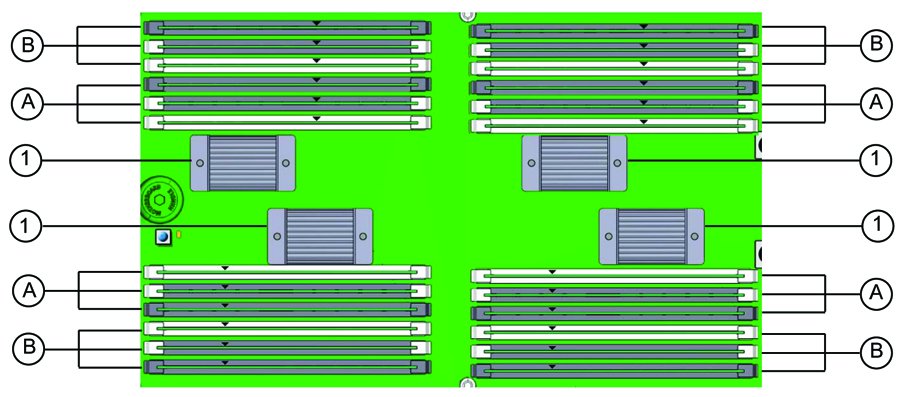Memory and DIMM Reference
This section includes the following information about memory, DIMMs, and DIMM population:
DIMM Specifics
-
Supported DIMM speeds: 1333 and 1600 MHz.
-
All supported DIMMs, regardless of speed rating, operate at 1333MHz.
-
Mixing of different size memory within one CMOD is not allowed (see DIMM Rules).
-
Mixing of LVDIMM and LRDIMM in the same chassis is not allowed.
Memory Buffers and Channels
All system memory is contained on the CPU modules (CMODs). Each CMOD contains 24 DIMM slots arranged in four groups of six slots. Each group of slots is controlled by one of the four memory buffers. Each buffer has two independent memory channels, A and B (eight memory channels per CMOD). Each channel supports 1-3 DIMMs and has three assigned DIMM slots. The following illustration shows the location of the memory buffers, the groups of DIMM slots, and the slots assigned to each channel.

|
DIMM Slot Numbering and Color Coding
For slot numbering information see Memory Slot Designations.
To differentiate the two memory channels within a group of slots, and to assist in DIMM population order, the three DIMM slots assigned to each channel have color-coded slots and levers. The color-coding is black slots with black levers, black slots with white levers, and white slots with white levers.
The following illustration shows the color code pattern for DIMM slots within one group of slots. The pattern is repeated for all groups of slots.

|
DIMM Rules
The DIMM installation rule aims to maximize the memory bandwidth available by spreading the memory across all eight memory channels.
When installing DIMMs, consider the following rules:
-
All DIMMs in a system should be the same type and size.
-
All CMODs should be populated identically.
-
The minimum DIMM configuration as shipped from the factory is four 16 GB DIMMs in each CMOD, installed is slots D0, D6, D12 and D18.
An upgrade of four DIMMs for each CMOD is allowed in this configuration by installing four DIMMs in slots D3, D9, D15 and D21.
-
Aside from an upgrade to the minimum shipped configuration (stated above), DIMMs must be added to each CMOD in sets of eight (one for each memory buffer channel). Add eight DIMMs to each CMOD starting with CMOD 0 and ending with CMOD 3 (four-CMOD configuration) or CMOD 7 (eight-CMOD configuration). After all CMODs are populated, go back to CMOD 0 and repeat the sequence adding the next set of eight to each CMOD.
For example: CMOD 0 gets the initial eight DIMMs, followed by CMOD 1 with the next eight DIMMs, continuing with all CMODs in the configuration. When 32 DIMMs (4-CMOD) or 64 DIMMs (8-CMOD) have been added across all CMODs in the configuration, go back to CMOD 0 for the next set of eight and continue this population pattern.
-
Each CMOD must only contain one size of DIMM. Mixing of different size memory within a CMOD is not allowed; however, size mixing between CMODs is allowed.
-
Mixing of LVDIMM and LRDIMM in the same schassis is not allowed.
DIMM Slot Population Order
The DIMM slot population order is as follows:
Note - Always populate the DIMM slot furthest from the memory buffer first.
-
Populate the slots with black slots and black levers: D0, D3, D6, D9, D12, D15, D18, D21
The slot population for the minimum DIMM configuration is D0/D6/D12/D18 per CMOD
-
Populate the slots with black slots and white levers: D1, D4, D7, D10, D13, D16, D19, D22
-
Populate the white slot, white lever slots: D2, D5, D8, D11, D14, D17, D20, D23